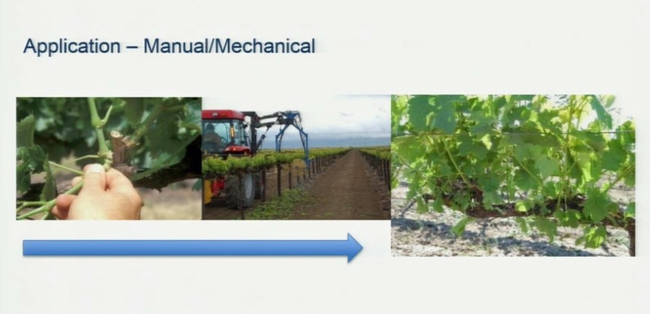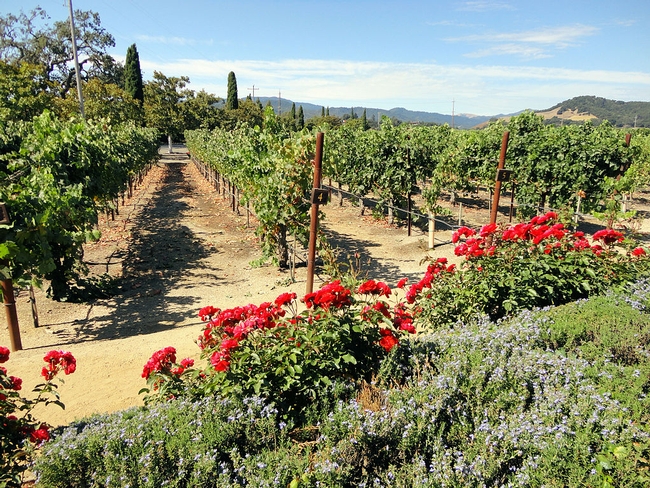Posts Tagged: winegrapes
Mechanical winegrape management produces superior grapes
UC Cooperative Extension specialist Kaan Kurtural is managing a vineyard at the 40-acre UC Oakville Field Station in Napa County with virtually no manual labor, reported Tim Hearden in Capital Press.
“We set this up to be a no-touch vineyard,” Kurtural said. “All the cultural practices are done by machine.”
Kurtural's original intent was to help farmers deal with labor shortages, but the trial also produced superior winegrapes.
“When I took the job at the University of California, the labor situation started to get worse,” Kurtural said. “If we didn't have people to prune grapes, we weren't able to finish pruning. So we said, ‘We are a research station, let's develop a solution.'”
In the research vinyard:
- A machine equipped with telemetry and GPS sensors prunes the vines
- Soil and canopy data are collected manually
- Spurs and suckers are thinned with a specially designed pruner
- Clusters are thinned mechanically
- The grapes are harvested mechanically
“We can do all the practices mechanically now,” he said. “There was no economic need to do this previously, but now there is.”
Kurtural attributes the winegrape quality improvements to the tall canopy, which protects grapes from sun damage. The system also uses less water.
For complete details, watch a 40-minute lecture by Kaan Kutural online
Dry-land farming of winegrapes has a place in Napa and Sonoma
Grapes farmed in Northern California's famed "Wine Country" can be successfully produced with no irrigation water applied at all, reported Ellen Knickmeyer of the Associated Press.
She spoke to farmer Frank Leeds, who produces grapes in Napa Valley without adding water, not because of the drought, but because he believes the practice produces the best wine. Another option some farmers are using is deficit irrigation, which provides irrigation water at carefully timed intervals.
The farmers believe dryland farming and deficit irrigation force the vines to develop deeper roots that give wine distinctive "terroir" notes, flavor character it derives from the environment. But they must be cautious to avoid the dreaded "r" word - raisin, said a UC Agriculture and Natural Resources (UC ANR) expert.
"I do know that (various) wineries have a preference, but the overarching preference is that the fruit is sound and it arrives at the winery not shriveled up as a raisin," said UC ANR Cooperative Extension advisor Rhonda Smith.
Winegrape growers concerned about drought
Winegrape growers who rely on groundwater are worried about the dismal rainy season so far, reported Ed Joyce on Capital Public Radio. He quoted the National Oceanic and Atmospheric Administration as saying that, barring "epic rain and snowfall," the drought will likely continue through the spring and summer.
Joyce spoke to a a dismayed winemaker, a worried vineyard manager and he gathered background for his four-minute story by interviewing Lynn Wunderlich, UC Cooperative Extension farm advisor for El Dorado, Amador, Calaveras and Tuolumne counties.
"There's a lot of concern out there amongst growers that I work with in the four counties in the Central Sierra," Wunderlich said. "Generally in the foothills we have a shorter depth in the soil from the surface to the bedrock, so that all impacts the available water that a grower has."
Because of the drought, Wunderlich said some growers are extending their wells or digging new wells to increase groundwater supply.
"I even had an email from a small grape grower who said he's collected rainwater this season," Wunderlich said. "So people are getting quite creative in their attempts to conserve water, knowing that we're going to have potentially a tough season."
A Treasury bond nets greater return than vineyard
The Stockton Record yesterday ran a story about the dismal economics associated with growing grapes in the San Joaquin Valley, based on a study co-authored by UC Cooperative Extension viticulture advisor in San Joaquin County Paul Verdegaal.
The story, written by veteran ag reporter Reed Fujii, opened with a telling quote from local farmer Brad Goehring, who helped with the cost study.
"At best, we're looking at about a 4 percent return on investment," he was quoted. "You could sell your land, liquidate everything, put your money into a Treasury bill and earn essentially the same return."
The UC cost-of-production study, based on a hypothetical vineyard, estimates that year-to-year operating profits of less than $1,000 an acre get eaten up by overhead costs, such as taxes, insurance and management expenses. The value of land, initial vineyard planting costs, farm buildings and equipment runs the accounting deep into the red, losing more than $2,000 an acre, the Record's story reported.
The sad conclusion was given in a quote from Verdegaal:
"In a true economic sense ... grape growing, or probably most of agriculture, from what we've seen the last few years anyway, doesn't pay."
The story ended with one ray of hope. It says the long down cycle in winegrape prices may be on the upswing. Growers and others have recently reported spot market prices of $500 to $550 a ton for cabernet sauvignon and $600 for chardonnay, Fujii wrote. That's much higher than the $393 per ton average for last year.
The cost study, Sample Costs to Establish and Produce Winegrapes (Cabernet Sauvignon),



